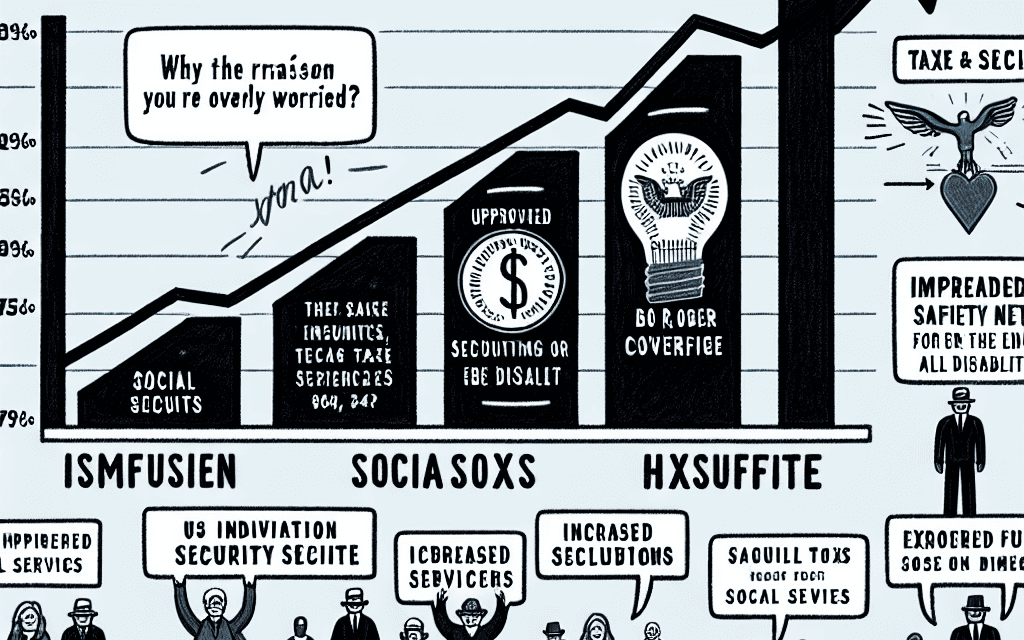“Securing Your Future: Why 2025’s Social Security Tax Boost is a Step Towards Stability”
Introduction
In 2025, the prospect of increased Social Security taxes may initially raise concerns among workers and retirees alike. However, a closer examination reveals that these changes are designed to ensure the long-term sustainability and reliability of the Social Security system, which serves as a critical safety net for millions of Americans. The adjustments in tax rates are a proactive measure to address the demographic shifts and financial pressures facing the program, ultimately safeguarding future benefits. By understanding the rationale behind these tax increases and the broader context of Social Security’s role in providing economic security, individuals can appreciate the necessity of these changes and feel reassured about the program’s continued ability to support them in their retirement years.
Understanding The Purpose Of Social Security Taxes
In recent discussions about fiscal policy, the topic of increased Social Security taxes in 2025 has emerged as a point of concern for many individuals. However, understanding the purpose of Social Security taxes can alleviate much of this apprehension. Social Security taxes are a fundamental component of the broader social safety net, designed to ensure financial stability for retirees, disabled individuals, and survivors of deceased workers. As the population ages and life expectancy increases, the demand on Social Security funds intensifies, necessitating adjustments to maintain the program’s solvency.
To comprehend why increased Social Security taxes should not be a cause for alarm, it is essential to recognize the program’s foundational role in providing economic security. Social Security was established during the Great Depression, a time when economic uncertainty was rampant, and many older Americans faced poverty. The program was designed to offer a reliable source of income to those who could no longer work, thereby reducing poverty rates among the elderly. Over the decades, it has evolved to include benefits for disabled individuals and survivors, further expanding its reach and impact.
The anticipated increase in Social Security taxes in 2025 is a proactive measure to address the demographic shifts and financial challenges facing the program. As the baby boomer generation continues to retire, the ratio of workers to beneficiaries is decreasing, placing additional strain on the system. By adjusting the tax rate, policymakers aim to ensure that Social Security can continue to fulfill its promises to current and future beneficiaries. This adjustment is not unprecedented; throughout its history, Social Security has undergone various modifications to adapt to changing economic and demographic conditions.
Moreover, it is important to consider the broader economic implications of maintaining a robust Social Security system. By providing a stable source of income to millions of Americans, Social Security contributes to overall economic stability. Beneficiaries use their payments to cover essential expenses, such as housing, healthcare, and food, which in turn supports local economies. In this way, Social Security acts as an economic stabilizer, particularly during times of economic downturns, by ensuring that a significant portion of the population maintains purchasing power.
Furthermore, the increase in Social Security taxes is a reflection of a collective investment in societal well-being. By contributing to the program, individuals are not only securing their own future but also supporting a system that benefits the community as a whole. This sense of shared responsibility is a cornerstone of the Social Security program, fostering a sense of solidarity across generations.
In conclusion, while the prospect of increased Social Security taxes in 2025 may initially seem concerning, a deeper understanding of the program’s purpose and the rationale behind the adjustment reveals its necessity and benefits. By ensuring the long-term solvency of Social Security, these changes help preserve a vital safety net that supports millions of Americans. As such, rather than viewing the increase as a burden, it should be seen as a prudent step towards sustaining a program that has been instrumental in promoting economic security and stability for nearly a century.
How Increased Taxes Ensure Long-Term Benefits
The prospect of increased Social Security taxes in 2025 has sparked considerable debate among taxpayers and policymakers alike. However, it is essential to understand that these changes are designed to ensure the long-term sustainability of the Social Security program, which serves as a critical safety net for millions of Americans. By examining the rationale behind these tax adjustments, one can appreciate how they contribute to the program’s enduring viability and, ultimately, benefit society as a whole.
To begin with, Social Security is a foundational element of the American social safety net, providing financial support to retirees, disabled individuals, and survivors of deceased workers. As the population ages and life expectancy increases, the demand for Social Security benefits continues to rise. This demographic shift places significant pressure on the program’s financial resources, necessitating adjustments to ensure its solvency. Consequently, the decision to increase Social Security taxes is a proactive measure aimed at addressing these challenges.
Moreover, it is important to recognize that the Social Security program operates on a pay-as-you-go basis, meaning that current workers’ contributions fund the benefits of current retirees. As the ratio of workers to beneficiaries decreases, the program faces potential shortfalls. By increasing taxes, the government can bolster the Social Security trust fund, thereby securing the program’s ability to meet its obligations in the future. This approach not only addresses immediate funding concerns but also lays the groundwork for a more stable and reliable system for generations to come.
In addition to ensuring the program’s financial health, increased Social Security taxes can also lead to enhanced benefits for recipients. As the cost of living continues to rise, it is crucial that Social Security benefits keep pace with inflation to maintain their purchasing power. By strengthening the program’s financial foundation through increased taxes, there is greater potential for benefit adjustments that reflect the true cost of living. This ensures that beneficiaries can maintain a reasonable standard of living, even as economic conditions evolve.
Furthermore, it is worth considering the broader economic implications of a well-funded Social Security program. By providing a stable source of income for retirees and other beneficiaries, Social Security contributes to overall economic stability. Beneficiaries who receive adequate support are more likely to spend their benefits on goods and services, thereby stimulating economic activity and supporting job creation. In this way, increased Social Security taxes can have a positive ripple effect throughout the economy, benefiting not only individual recipients but also society at large.
While the prospect of higher taxes may initially seem daunting, it is crucial to view these changes in the context of their long-term benefits. By ensuring the sustainability of the Social Security program, increased taxes help protect the financial security of current and future beneficiaries. This, in turn, supports economic stability and growth, creating a more prosperous society for all. As such, rather than being a cause for concern, increased Social Security taxes in 2025 should be seen as a necessary and prudent step toward securing a brighter future for everyone.
The Impact On Future Generations’ Security
The prospect of increased Social Security taxes in 2025 has sparked considerable debate among policymakers and the public alike. However, it is essential to understand that these changes are designed with the long-term security of future generations in mind. While the immediate reaction may be one of concern, a closer examination reveals that the benefits of such adjustments far outweigh the drawbacks.
To begin with, Social Security is a critical component of the social safety net, providing financial support to retirees, disabled individuals, and survivors of deceased workers. As the population ages and life expectancy increases, the strain on the Social Security system intensifies. Consequently, without intervention, the program risks becoming unsustainable, potentially leading to reduced benefits for future beneficiaries. By increasing Social Security taxes, the government aims to bolster the program’s financial health, ensuring that it can continue to serve its purpose for generations to come.
Moreover, it is important to consider the demographic shifts that are occurring. The baby boomer generation is retiring in large numbers, leading to a higher ratio of beneficiaries to working contributors. This demographic imbalance places additional pressure on the Social Security system. By adjusting the tax structure, the government can address this imbalance, ensuring that the system remains robust and capable of supporting an aging population. In this context, increased taxes are not merely a financial burden but a necessary step to maintain the program’s viability.
Furthermore, the increased taxes are likely to be implemented in a manner that minimizes the impact on lower-income earners. Policymakers are aware of the potential burden on working families and are expected to design the tax changes in a progressive manner. This means that higher-income individuals will bear a larger share of the tax increase, thereby protecting those who are less financially secure. Such a progressive approach ensures that the tax system remains equitable while still achieving the necessary funding for Social Security.
In addition to securing the future of Social Security, increased taxes can also have positive economic implications. By ensuring the stability of the program, the government can provide greater certainty to future retirees, allowing them to plan their finances with confidence. This, in turn, can lead to increased consumer spending and investment, as individuals feel more secure about their financial future. The ripple effect of such economic stability can contribute to overall economic growth, benefiting society as a whole.
It is also worth noting that the increased taxes are part of a broader strategy to address long-term fiscal challenges. As healthcare costs rise and other entitlement programs face similar pressures, a comprehensive approach is necessary to ensure the sustainability of public finances. By taking proactive measures now, the government can avoid more drastic and potentially disruptive changes in the future.
In conclusion, while the prospect of increased Social Security taxes in 2025 may initially seem concerning, it is a prudent and necessary step to ensure the long-term security of future generations. By addressing demographic shifts, implementing progressive tax changes, and contributing to economic stability, these adjustments serve the greater good. Ultimately, the focus should be on the benefits that such changes will bring, rather than the immediate costs, as they lay the foundation for a more secure and prosperous future for all.
Comparing Social Security Taxes To Other Countries

As discussions about the future of Social Security continue to unfold, the prospect of increased Social Security taxes in 2025 has become a focal point of concern for many Americans. However, when we compare the Social Security tax rates in the United States to those in other countries, it becomes evident that the proposed changes should not be a cause for alarm. Understanding the broader context of global social security systems can provide valuable insights into why these adjustments are not only necessary but also relatively moderate.
To begin with, it is important to recognize that Social Security systems worldwide are designed to provide financial support to individuals during retirement, disability, or other life circumstances that limit their ability to earn an income. In the United States, the Social Security program is primarily funded through payroll taxes, which are shared between employers and employees. Currently, the combined Social Security tax rate in the U.S. is 12.4%, with employees and employers each contributing 6.2%. While this rate may seem significant, it is relatively modest when compared to the contributions required in many other developed nations.
For instance, in several European countries, social security contributions are considerably higher. In Germany, employees and employers each contribute approximately 18.6% of an employee’s salary to the social security system. Similarly, in France, the combined social security tax rate can exceed 25%, depending on the specific benefits and programs included. These higher rates reflect a broader commitment to comprehensive social welfare systems that provide extensive benefits, including healthcare, unemployment insurance, and family support, in addition to retirement pensions.
Moreover, the proposed increase in Social Security taxes in the United States is intended to address the long-term sustainability of the program. As the population ages and life expectancy increases, the ratio of workers to beneficiaries is declining, placing additional strain on the system. By modestly increasing the tax rate, the U.S. aims to ensure that Social Security remains solvent and capable of meeting its obligations to future generations. This proactive approach is not unique to the United States; many countries have implemented similar measures to adapt to demographic changes and economic challenges.
Furthermore, it is essential to consider the benefits that Social Security provides to American citizens. The program serves as a critical safety net, offering financial security to millions of retirees, disabled individuals, and surviving family members. By contributing to Social Security, individuals are investing in their own future well-being and that of their fellow citizens. The peace of mind that comes from knowing there is a reliable source of income in retirement or during times of need is invaluable.
In conclusion, while the prospect of increased Social Security taxes in 2025 may initially raise concerns, a comparative analysis with other countries reveals that the proposed changes are both reasonable and necessary. The United States’ Social Security tax rates remain relatively low compared to those in many other developed nations, and the adjustments are aimed at ensuring the program’s long-term viability. By understanding the global context and the benefits provided by Social Security, Americans can appreciate the importance of these changes and feel confident in the continued strength of this vital social safety net.
The Role Of Social Security In Economic Stability
The role of Social Security in maintaining economic stability cannot be overstated, as it serves as a crucial safety net for millions of Americans. As we look toward 2025, discussions surrounding increased Social Security taxes have sparked concern among some citizens. However, a closer examination reveals that these changes should not be a cause for alarm. Instead, they represent a necessary adjustment to ensure the long-term sustainability of the program, which is vital for economic stability.
To begin with, Social Security is a foundational element of the American social safety net, providing financial support to retirees, disabled individuals, and survivors of deceased workers. It plays a significant role in reducing poverty among the elderly and offers a reliable source of income for those who may not have sufficient savings or pensions. As the population ages and life expectancy increases, the demand for Social Security benefits continues to rise. Consequently, the system requires periodic adjustments to maintain its solvency and effectiveness.
In this context, the proposed increase in Social Security taxes in 2025 is a proactive measure designed to address the program’s long-term funding challenges. The Social Security Administration has projected that, without intervention, the trust fund reserves could be depleted by the mid-2030s. This scenario would result in a reduction of benefits, which could have severe implications for economic stability, particularly for those who rely heavily on these payments. By increasing taxes now, the government aims to bolster the program’s financial health, ensuring that it can continue to provide essential support to future generations.
Moreover, it is important to recognize that the proposed tax increase is relatively modest and is structured to minimize the impact on most taxpayers. The adjustment primarily targets higher-income earners, who are better positioned to absorb the additional cost. This approach helps to distribute the financial burden more equitably, ensuring that those with greater means contribute a fair share to the program’s sustainability. For the majority of workers, the change in tax rates will be negligible, and the long-term benefits of a stable Social Security system far outweigh the short-term costs.
Furthermore, maintaining a robust Social Security program has broader economic implications. By providing a steady income to retirees and other beneficiaries, Social Security helps to sustain consumer spending, which is a key driver of economic growth. In times of economic downturn, these payments act as an automatic stabilizer, helping to cushion the impact of recessions by maintaining demand for goods and services. Thus, ensuring the program’s solvency is not only a matter of social responsibility but also an essential component of economic policy.
In conclusion, while the prospect of increased Social Security taxes in 2025 may initially raise concerns, it is important to view this change within the broader context of economic stability and social welfare. The adjustment is a necessary step to secure the future of a program that millions of Americans depend on for financial security. By addressing funding challenges now, we can preserve the integrity of Social Security for future generations, ensuring that it continues to play its vital role in supporting individuals and stabilizing the economy. Therefore, rather than being a cause for concern, the proposed tax increase should be seen as a prudent investment in the nation’s economic future.
Dispelling Myths About Social Security Solvency
As discussions about the future of Social Security continue to dominate public discourse, the announcement of increased Social Security taxes in 2025 has sparked a wave of concern among many Americans. However, it is essential to dispel the myths surrounding Social Security solvency and understand why these tax adjustments should not be a cause for alarm. To begin with, Social Security is a critical program that provides financial support to millions of retirees, disabled individuals, and survivors of deceased workers. It is funded primarily through payroll taxes, which are contributions made by both employees and employers. The program’s solvency has been a topic of debate for decades, with concerns often arising about its ability to meet future obligations. Nevertheless, the increase in Social Security taxes is a proactive measure designed to ensure the program’s long-term sustainability.
One of the primary reasons for the tax increase is the demographic shift occurring in the United States. As the baby boomer generation continues to retire, the ratio of workers to beneficiaries is decreasing. This demographic change places additional pressure on the Social Security system, necessitating adjustments to maintain its financial health. By increasing taxes, the government aims to bolster the Social Security trust fund, ensuring that it can continue to provide benefits to future generations. Moreover, it is important to recognize that the increase in Social Security taxes is not unprecedented. Historically, adjustments to payroll taxes have been made periodically to address changing economic and demographic conditions. These adjustments have been instrumental in maintaining the program’s solvency and ensuring that it can fulfill its obligations. Therefore, the 2025 tax increase should be viewed as a continuation of this prudent fiscal management rather than an alarming development.
Furthermore, the impact of the tax increase on individual taxpayers is likely to be minimal. While any increase in taxes may initially seem burdensome, it is crucial to consider the broader context. The additional funds generated by the tax increase will contribute to the stability of the Social Security system, providing a safety net for millions of Americans. In this light, the tax adjustment can be seen as an investment in the future well-being of society as a whole. Additionally, it is worth noting that Social Security benefits are a vital source of income for many retirees, often serving as their primary or sole means of financial support. Ensuring the program’s solvency is essential to safeguarding the financial security of current and future beneficiaries. By addressing potential shortfalls through tax adjustments, the government is taking proactive steps to protect the interests of those who rely on Social Security.
In conclusion, while the prospect of increased Social Security taxes in 2025 may initially raise concerns, it is important to dispel the myths surrounding the program’s solvency. The tax adjustment is a necessary measure to address demographic changes and ensure the long-term sustainability of Social Security. By understanding the rationale behind the tax increase and considering its minimal impact on individual taxpayers, it becomes clear that this development should not be a cause for alarm. Instead, it should be viewed as a responsible step towards securing the financial future of millions of Americans who depend on Social Security for their well-being.
How Increased Taxes Support Vulnerable Populations
In recent discussions about fiscal policy, the topic of increased Social Security taxes set to take effect in 2025 has sparked considerable debate. While the prospect of higher taxes often raises concerns among taxpayers, it is crucial to understand the broader implications and benefits of such measures. Specifically, the increase in Social Security taxes is designed to bolster support for vulnerable populations, ensuring that the most at-risk members of society receive the assistance they need. By examining the rationale behind these tax adjustments, we can appreciate how they contribute to a more equitable and sustainable social safety net.
To begin with, it is important to recognize that Social Security serves as a lifeline for millions of Americans, particularly the elderly, disabled, and low-income individuals. As the population ages and life expectancy increases, the demand for Social Security benefits continues to rise. Consequently, the system faces financial strain, necessitating adjustments to maintain its solvency. The increase in Social Security taxes is a proactive measure to address this challenge, ensuring that the program can continue to provide essential support to those who depend on it.
Moreover, the additional revenue generated from increased taxes will be instrumental in enhancing the benefits provided to vulnerable populations. For instance, many elderly individuals rely on Social Security as their primary source of income, and any enhancements to their benefits can significantly improve their quality of life. By increasing the tax rate, the government can allocate more resources to these individuals, helping them meet their basic needs and reducing the risk of poverty among seniors.
In addition to supporting the elderly, the increased Social Security taxes will also benefit individuals with disabilities. These individuals often face significant barriers to employment and financial stability, making Social Security benefits a critical component of their income. By strengthening the financial foundation of the Social Security system, the government can ensure that disabled individuals receive the support they need to live with dignity and independence.
Furthermore, the increased taxes will contribute to the overall stability of the Social Security system, which is essential for future generations. As the workforce evolves and economic conditions change, it is vital to have a robust and adaptable social safety net in place. By addressing the funding challenges now, the government is taking steps to secure the long-term viability of Social Security, ensuring that it remains a reliable source of support for those who need it most.
While the prospect of higher taxes may initially seem daunting, it is important to consider the broader societal benefits that result from such measures. By investing in the well-being of vulnerable populations, we are fostering a more inclusive and compassionate society. The increased Social Security taxes represent a commitment to social responsibility, reflecting a collective effort to support those who are most in need.
In conclusion, the increase in Social Security taxes set for 2025 should not be a cause for concern. Instead, it should be viewed as a necessary step towards strengthening the social safety net and ensuring that vulnerable populations receive the support they require. By understanding the rationale behind these tax adjustments and recognizing their long-term benefits, we can appreciate the positive impact they will have on society as a whole. Through this lens, the increased taxes are not merely a financial burden but a vital investment in the well-being and security of all citizens.
Q&A
1. **Question:** Why are Social Security taxes increasing in 2025?
**Answer:** Social Security taxes are increasing in 2025 to ensure the long-term sustainability of the Social Security program, addressing funding gaps due to demographic shifts like an aging population.
2. **Question:** How will the increased taxes impact the average worker?
**Answer:** The impact on the average worker will be relatively modest, with a small percentage increase in payroll taxes that is unlikely to significantly affect take-home pay.
3. **Question:** What benefits will result from the increased Social Security taxes?
**Answer:** The increased taxes will help maintain the solvency of the Social Security trust fund, ensuring that current and future retirees receive their full benefits without cuts.
4. **Question:** Are there any protections for low-income workers with the tax increase?
**Answer:** Yes, the tax increase is designed to be progressive, with higher earners contributing more, while low-income workers are protected from significant financial burden.
5. **Question:** How does the tax increase affect Social Security benefits?
**Answer:** The tax increase helps secure the funding necessary to maintain and potentially enhance Social Security benefits, preventing reductions in payouts.
6. **Question:** What is the long-term outlook for Social Security with the tax increase?
**Answer:** The long-term outlook is more stable, with the increased revenue helping to extend the solvency of the Social Security program for future generations.
7. **Question:** Why shouldn’t individuals be concerned about the tax increase?
**Answer:** Individuals shouldn’t be concerned because the increase is a proactive measure to ensure the reliability and availability of Social Security benefits, providing financial security in retirement.
Conclusion
Increased Social Security taxes in 2025 shouldn’t concern you because they are a necessary adjustment to ensure the long-term sustainability of the Social Security program, which provides critical financial support to millions of retirees, disabled individuals, and survivors. The increase is designed to address the demographic shifts and financial pressures facing the system, such as the aging population and longer life expectancies, which have strained resources. By contributing slightly more now, individuals help secure their own future benefits and those of future generations. Additionally, the economic impact on individuals is often minimal compared to the significant benefits of maintaining a robust and reliable Social Security system. This adjustment helps prevent more drastic measures in the future, ensuring that the program continues to fulfill its promise of financial security for all eligible Americans.





